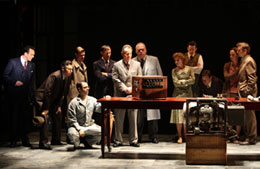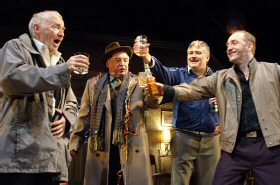Well, Ms. Maud, I’ll see your Angela Carter on gentrification and raise you some Donna Tartt on McMansions.
In a hair-raising scene early in The Little Friend, young Harriet and her friend Hely are attempting to capture a poisonous snake. Their hunt for copperheads takes them to Oak Lawn Estates, a newer subdivision of their Mississippi town where all the houses “are less than seven years old: mock Tudor, blocky ranch and contemporary, even a couple of fake antebellums of new, spanking-red brick, with ornamental columns tacked on to their facades.” To make way for these outsize, expensive homes, the ground has been razed and plucked of all trees:
But Oak Lawn had taken its own revenge at being planed so brutally flat. The land was swampy, and whining with mosquitos. Holes filled with brackish water as soon as they were dug in the ground. The sewage backed up when it rained–legendary black sludge that rose in the spanking-new commodes, dripped from the faucets and the fancy multiple-spray showerheads. With all the topsoil sliced away, truckloads and truckloads of sand had to be brought in to keep the houses from washing away in the spring: and there was nothing to stop turtles and snakes from crawling as far inland from the river as they pleased.
And Oak Lawn Estates was infested with snakes–big and small, poisonous or not, snakes that liked mud, and snakes that liked water, and snakes that liked to bask on dry rocks in the sunshine. On hot days, the reek of snake rose up from the very ground, just as murky water rose to fill footprints in the bulldozed earth. Ida Rhew compared he smell of snake musk to fish guts–buffalo carp, mud or channel cat, scavenger fish that fed off garbage. Edie, when digging a hole for an azalea or a rosebush, particularly in Garden Club civic plantings near the Interstate, said she knew her spade was close to a snake’s nest if she caught a whiff of something like rotten potatoes.

 While “The Farnsworth Invention” is as slick as “Studio 60 on the Sunset Strip,” it’s also impressively earnest, and its subject is the less-than-burning question of Who Really Invented TV. And you know what? It’s good. Not great, you understand, but a rock-solid two-base hit.
While “The Farnsworth Invention” is as slick as “Studio 60 on the Sunset Strip,” it’s also impressively earnest, and its subject is the less-than-burning question of Who Really Invented TV. And you know what? It’s good. Not great, you understand, but a rock-solid two-base hit. Conor McPherson has given us a Christmas show for the suicidally depressed. “The Seafarer” is one of those capital-I Irish plays whose characters, one of whom (Ciarán Hinds) turns out to be the Divvil Himself, get falling-down drunk, hint broadly that there’s more to life than death and spout four- and seven-letter words starting with “f” in rich, peaty brogues. It is also–no fooling–worthy of comparison with the finest work of the young Brian Friel.
Conor McPherson has given us a Christmas show for the suicidally depressed. “The Seafarer” is one of those capital-I Irish plays whose characters, one of whom (Ciarán Hinds) turns out to be the Divvil Himself, get falling-down drunk, hint broadly that there’s more to life than death and spout four- and seven-letter words starting with “f” in rich, peaty brogues. It is also–no fooling–worthy of comparison with the finest work of the young Brian Friel.